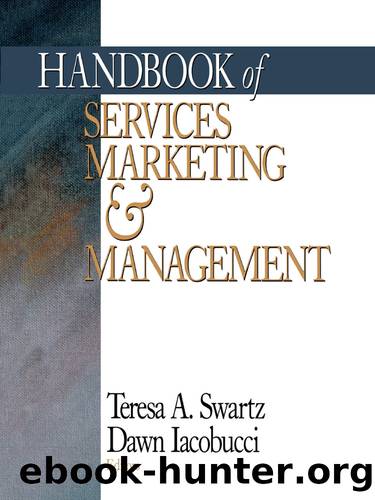Handbook of Services Marketing and Management by Swartz Teresa A.;Iacobucci Dawn; & Dawn Iacobucci

Author:Swartz, Teresa A.;Iacobucci, Dawn; & Dawn Iacobucci
Language: eng
Format: epub
ISBN: 1629340
Publisher: SAGE Publications, Incorporated
Published: 1999-11-19T00:00:00+00:00
Linking Customer Satisfaction to Financial Performance
Anderson, Fornell, and Lehmann (1994) provide a theoretical and empirical investigation of the relationship between customer satisfaction and profitability Many companies are frustrated that their efforts to improve quality are not translating quickly enough into economic returns; these authors develop a theoretical rationale for why and when such returns should be expected and empirically show that there are strong returns for those firms that increase quality. An annual one-point increase in customer satisfaction has a net present value of $7.48 million over 5 years for a typical firm in Sweden. Given the sampleâs average net income of $65 million, this represents a cumulative increase of 11.5%. If the impact of customer satisfaction on profitability is similar for firms in the Business Week 1000, then an annual one-point increase in the average firmâs satisfaction index would be worth $94 million or 11.4% of current return on investment (ROI). Thus, the research provides hope to managers who might otherwise curtail or abandon their efforts in this area.
Anderson, Fornell, and Rust (1997) investigate the links between customer satisfaction, productivity, and profitability. Although there is widespread belief that customer satisfaction and productivity operate in concert, there is reason to doubt whether this is necessarily the case for organizations in which service plays an important role. A model relating customer satisfaction and productivity to profitability is developed and used to generate hypotheses for when we should, and should not, expect synergies, or perhaps trade-offs, between customer satisfaction and productivity Specifically, there are more likely to be trade-offs between customer satisfaction and productivity when customersâ perceptions of quality are more dependent on customization (i.e., whether or not the product fits the customerâs requirements) as opposed to standardization (i.e., whether or not the product reliably performs its function). To test the modelâs propositions, it is argued that customer satisfaction for firms in service industries is relatively dependent on customization, whereas customer satisfaction in goods industries is relatively dependent on standardization. The empirical analysis finds that although improvements in both productivity and customer satisfaction are associated with higher profits for goods manufacturers, higher levels of one or the other, but not both simultaneously, are associated with higher returns for services. The somewhat counterintuitive implications of the study are that such firms should emphasize either productivity or customer satisfaction at any one time, but rarely both, as is commonly observed in practice.
The empirical evidence that the ACSI is a leading indicator of financial performance is becoming increasingly persuasive. This fact is true for accounting profits as well as shareholder value. Specifically, it has been shown that both the ACSI (Ittner and Larcker 1996) and its Swedish counterpart (Anderson, Fornell, and Lehmann 1994) have a positive association with ROI. In terms of market value, Ittner and Larcker (1996) estimate that a one-unit change in ACSI is associated with a $654 million increase in the market value of equity above and beyond the accounting book value of assets and liabilities. Stock trading strategies based on either
Download
This site does not store any files on its server. We only index and link to content provided by other sites. Please contact the content providers to delete copyright contents if any and email us, we'll remove relevant links or contents immediately.
Influence: The Psychology of Persuasion by Robert B. Cialdini(4198)
The Miracle Morning by Hal Elrod(3933)
The Hacking of the American Mind by Robert H. Lustig(3594)
Pre-Suasion: A Revolutionary Way to Influence and Persuade by Robert Cialdini(3436)
Unlabel: Selling You Without Selling Out by Marc Ecko(3001)
Hidden Persuasion: 33 psychological influence techniques in advertising by Marc Andrews & Matthijs van Leeuwen & Rick van Baaren(2801)
Who Can You Trust? by Rachel Botsman(2738)
Kick Ass in College: Highest Rated "How to Study in College" Book | 77 Ninja Study Skills Tips and Career Strategies | Motivational for College Students: A Guerrilla Guide to College Success by Fox Gunnar(2726)
Purple Cow by Seth Godin(2712)
Ogilvy on Advertising by David Ogilvy(2706)
I Live in the Future & Here's How It Works by Nick Bilton(2538)
This Is Marketing by Seth Godin(2503)
The Marketing Plan Handbook: Develop Big-Picture Marketing Plans for Pennies on the Dollar by Robert W. Bly(2425)
The Power of Broke by Daymond John(2391)
Building a StoryBrand by Donald Miller(2376)
The 46 Rules of Genius: An Innovator's Guide to Creativity (Voices That Matter) by Marty Neumeier(2322)
Draw to Win: A Crash Course on How to Lead, Sell, and Innovate With Your Visual Mind by Dan Roam(2286)
The Tipping Point by Malcolm Gladwell(2213)
Market Wizards by Jack D. Schwager(2177)
